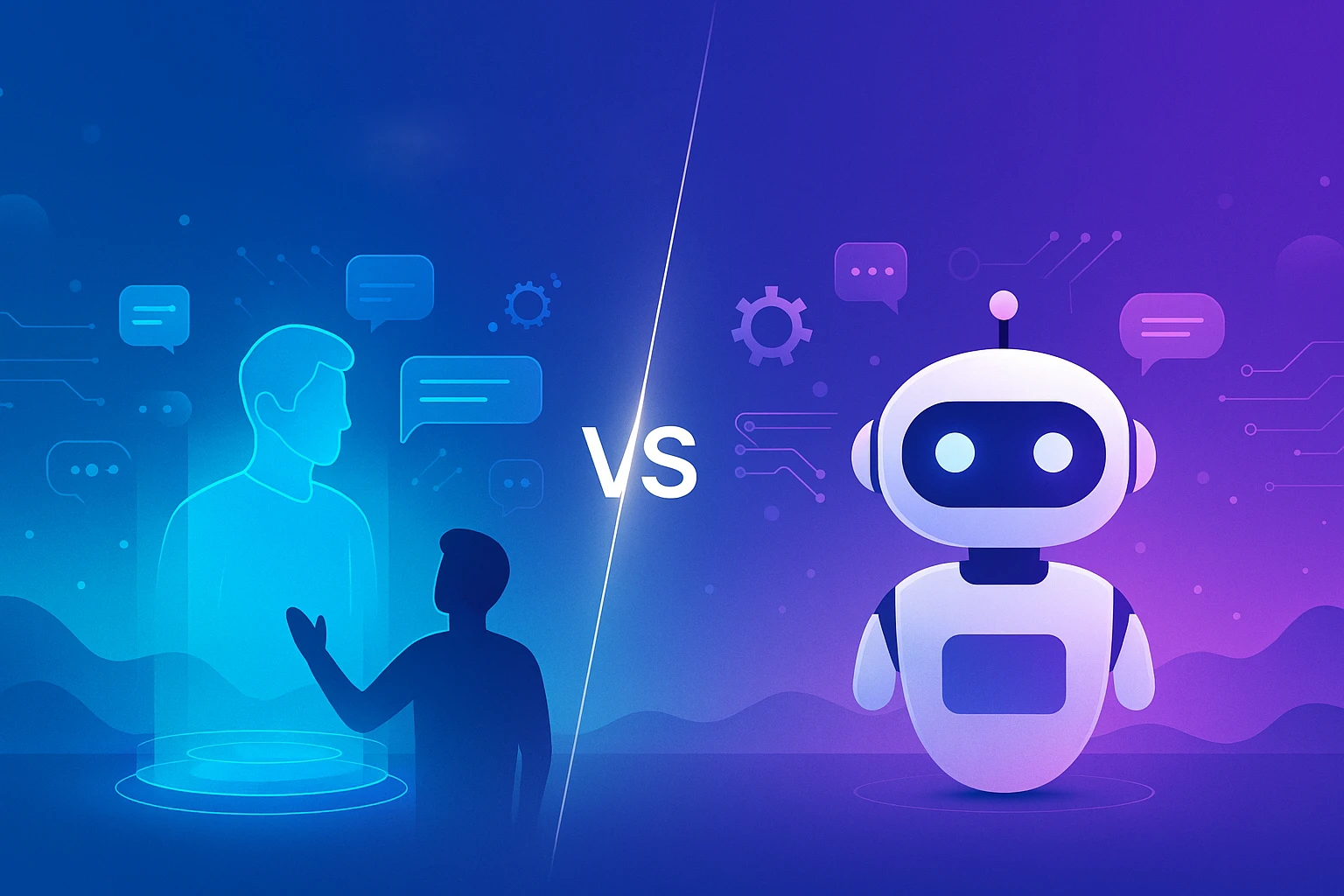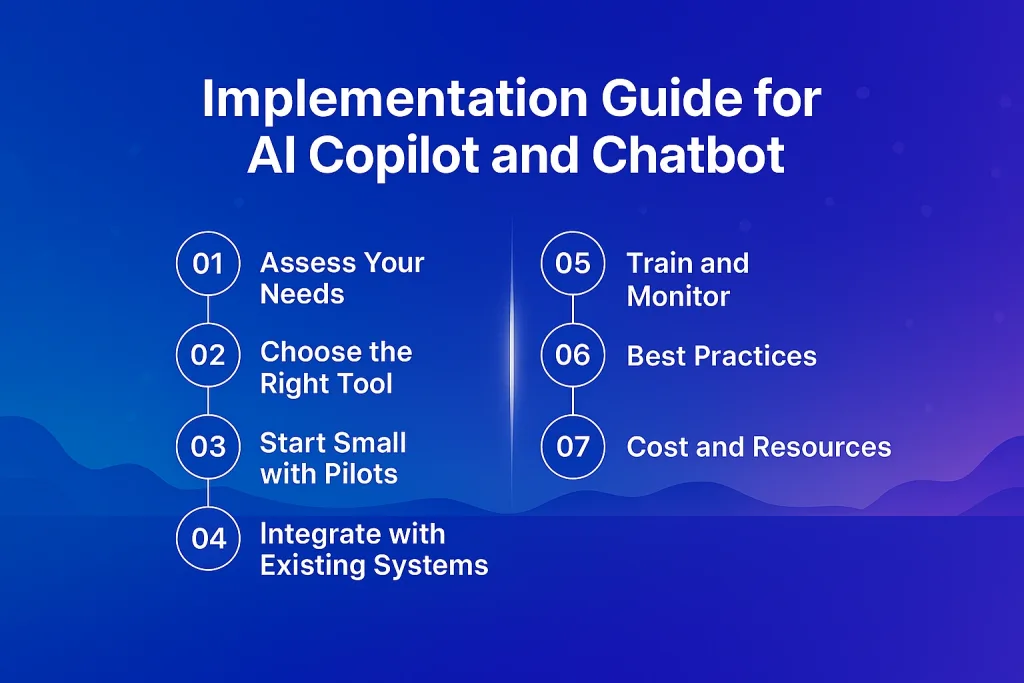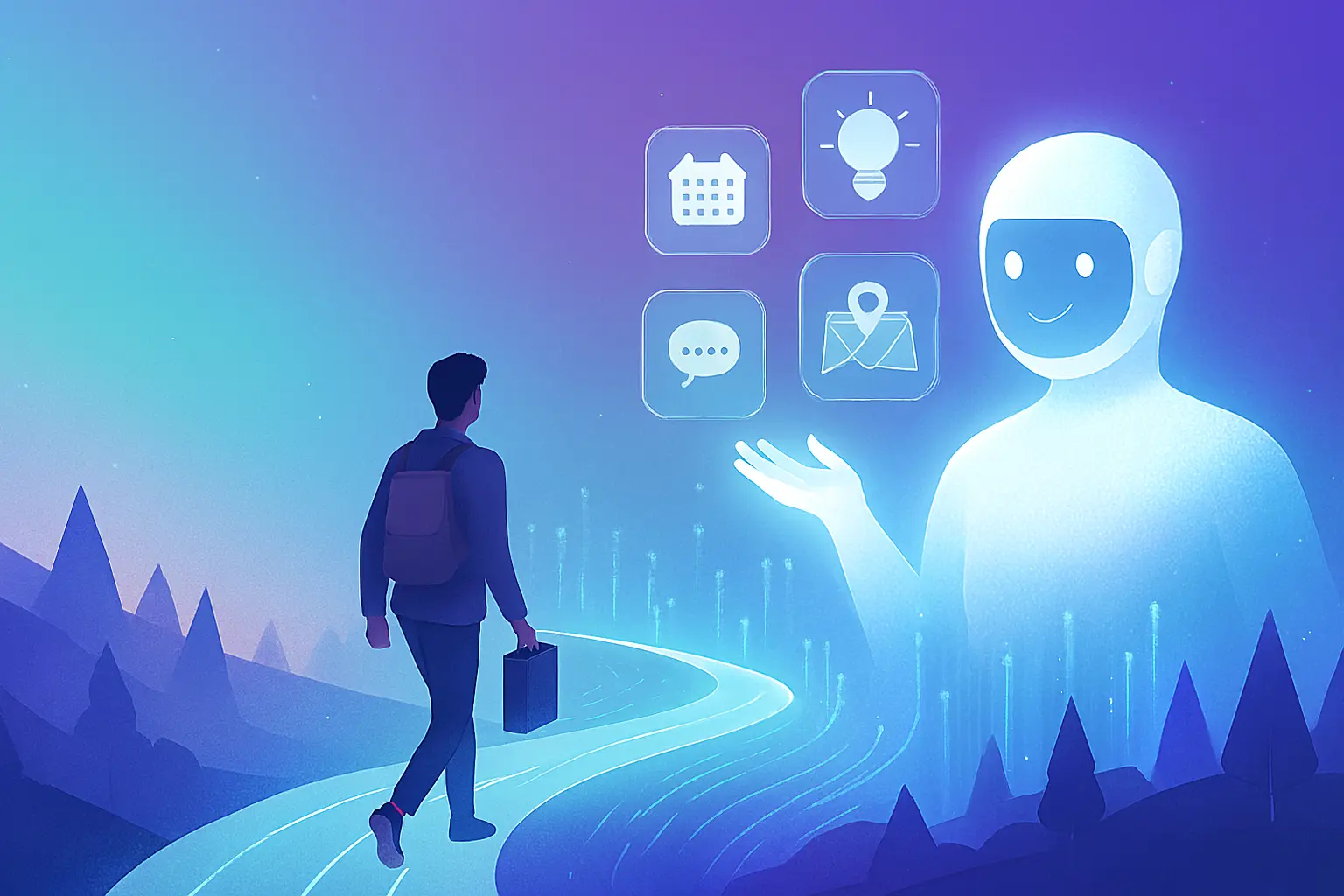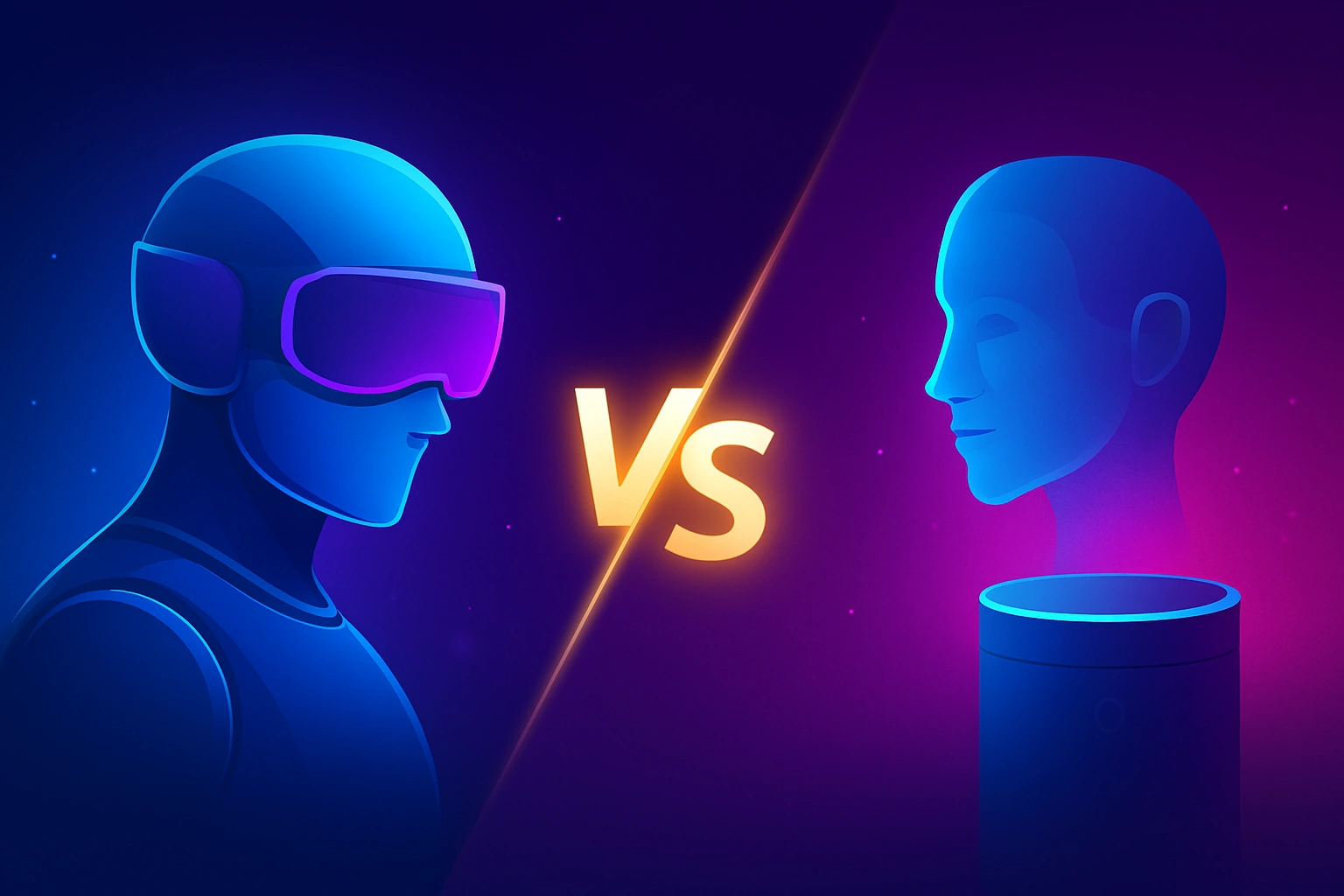AI Copilot vs AI Chatbot: A Comprehensive Comparison for Businesses
- October 16, 2025
- 14 mins read
- Listen

What if AI could handle 95% of your customer interactions by now? Projections from experts like Servion Global highlight this shift. Yet many struggle. So, is it time for an AI Chatbot or an AI Copilot? The AI Copilot vs AI Chatbot choice puzzles leaders.
Chatbots converse simply. They match intents to answers, provide proper context, and can be quickly deployed. On the other hand, Copilots collaborate. They weave into apps, generate ideas, and automate beyond conversations. In AI in customer service, chatbots triage basics while Copilots empower depth.
This comprehensive look at AI Copilot vs AI Chatbot clears the fog. We define each and highlight differences in tables: reactive vs proactive, scope from queries to tasks, use cases, and so on. Let’s dive right into it.
What is an AI Chatbot?
An AI chatbot is a software tool. It chats with users. It uses text or voice. It feels like talking to a person. Some follow strict rules. Others learn from data. The best use of generative AI, like GPT models. They answer questions fast. They help customers anytime. They power AI in customer service with quick replies.
Chatbots shine in high-volume settings. They tackle repetitive tasks. Picture an e-commerce site.
A chatbot answers “Where’s my order?” instantly. It pulls tracking data. It cuts wait times. Studies show chatbots reduce support tickets by up to 50%.
What is an AI Copilot?
An AI Copilot is a smart tool. It works alongside humans. It helps with tasks in real time. Unlike basic assistants, it integrates deeply into workflows.
It uses advanced AI, like large language models, to suggest actions, generate content, or automate steps. It feels like a partner, not just a responder. In AI in customer service, copilots boost efficiency beyond simple chats.
In AI in customer service, copilots empower agents. They don’t just answer queries. They suggest responses based on past interactions.
They automate tasks like updating records. For instance, a copilot can pull a customer’s order history and recommend solutions. This cuts resolution time.
Key Differences: AI Copilot vs AI Chatbot
Businesses leverage AI in customer service to enhance user experiences and streamline operations. Chatbots excel in dynamic, engaging conversations, handling high volumes of interactions with ease.
AI Copilots thrive in collaborative environments, embedding into workflows to boost productivity. For AI tools for customer support, both are heroes in their own right. Chatbots drive fast, conversational resolutions.
| Aspect | AI Chatbot | AI Copilot |
| Design | Proactive in advanced models. Focuses on dynamic conversations and user engagement. | Proactive. Anticipates needs. Task-oriented, embedded in tools. |
| Intelligence | Uses LLMs for advanced, contextual conversations and smart responses. | Advanced LLMs like GPT. Deep context, generative capabilities. |
| Integration | Deep system integration (e.g., CRM, websites, apps). | Deep workflow embedding in Live Chat and Ticketing. |
| Autonomy | Medium in advanced setups. Handles interactions with smart escalation. | Medium. Suggests actions but is human-led. Partial to high autonomy. |
| Scope | Broad. Covers conversations, content creation, and diverse applications. | Broad. Cross-functional for productivity and analysis. |
| Functionality | Generates content, pulls from knowledge bases, and automates responses. | Generates content, simplifies tasks, and provides real-time insights. |
| Cost | Affordable plans that reduce overall expenses through high efficiency. | Higher enterprise plans with strong ROI from productivity boosts. |
| Scalability | Excellent for high-volume interactions. Handles basics seamlessly. | Enterprise-grade with governance. Manages complex operations. |
| Privacy | Compliant with standards like GDPR/SOC2. Secure data handling. | Strong. Data stays in tenant, complies with GDPR/SOC2. |
Design and Approach
AI Chatbots are proactive powerhouses in modern setups. They don’t just wait for input; they anticipate user needs with smart triggers.
A customer asks about a product, and the chatbot suggests options based on browsing history or preferences.
Its conversational focus makes it ideal for engaging AI in customer support. From e-commerce to help desks, chatbots keep interactions lively and responsive.
They build rapport instantly, enhancing user satisfaction. AI Copilots, equally proactive, take a task-oriented approach. Embedded in tools like CRMs or productivity suites, they predict needs before users ask.
An agent opens a support ticket, and the copilot instantly offers insights from past interactions. This design drives AI tools for customer support by reducing manual effort and aligning with complex workflows.
Both tools excel, chatbots in vibrant conversations, copilots in seamless collaboration.
Intelligence and Learning
In the AI Chatbot vs AI Copilot comparison, intelligence fuels their success. Chatbots harness large language models (LLMs) for advanced, contextual conversations. They maintain dialogue flow, understand intent, and craft tailored responses.
A user asks a nuanced question, and the chatbot adapts, pulling from vast knowledge bases. This makes them brilliant for dynamic AI in customer service. Copilots leverage cutting-edge LLMs like GPT, diving deeper into context.
They generate creative outputs, from reports to suggestions, learning from enterprise data. 59% of consumers expect GenAI to reshape service, and both tools deliver. Chatbots excel in conversational smarts, engaging users directly.
Copilots shine in analytical depth, processing complex patterns to aid decision-making. Both are heroes, elevating AI in customer support with their adaptive intelligence.
Integration Capabilities
Integration powers both tools in Chatbot vs AI Copilot. Chatbots offer robust system integration, connecting seamlessly to CRMs, websites, or apps.
They sync with customer data to provide instant replies, making setup flexible for businesses of all sizes. Small firms can deploy them quickly, enhancing AI in customer support without heavy investment.
Copilots take integration to another level. They access live data, emails, records, or analytics for real-time assistance.
Both shine: chatbots for broad, accessible connections and AI copilots for intricate, workflow-driven harmony.
Autonomy Levels
Autonomy balances efficiency and control. Advanced chatbots achieve medium autonomy, managing interactions with smart escalation. They resolve queries independently but hand off complex cases to humans seamlessly.
This makes them reliable for conversational AI in customer service, keeping users engaged without overstepping.
Copilots also offer medium autonomy, suggesting actions like drafting responses or updating records while keeping humans in charge.
Their partial autonomy ensures precision in tasks. Gartner predicts AI assistants like copilots will drive automation by 2028, but both tools already empower users.
Chatbots excel in independent, conversational flow. Copilots thrive in guided, collaborative tasks.
Together, they enhance AI in customer support with balanced autonomy.
Scope and Use Cases
Scope showcases versatility in AI Copilot vs AI Chatbot. Chatbots go beyond FAQs, tackling diverse tasks like sales, onboarding, or content creation. They guide users through purchases or troubleshoot issues, making them indispensable for broad AI in customer support applications.
Copilots match this breadth, supporting productivity across roles such as coding, analytics, or customer management. In AI in customer service, chatbots handle dynamic interactions across industries.
Copilots excel in cross-functional challenges, like analyzing trends for upsells. Both are vital heroes: chatbots for versatile conversations, copilots for multifaceted productivity.
Functionality and Output
Functionality highlights their unique strengths. Chatbots generate content, pull from knowledge bases, and automate responses with precision.
A customer asks about a service, and the chatbot crafts a personalized reply instantly. This efficiency powers AI tools for customer support in high-volume settings.
Copilots go further, generating content, automating tasks, and providing real-time insights. They summarize calls, update CRMs, or suggest solutions based on data.
Studies show both boost efficiency, chatbots by 50% for tickets, copilots by 20-45% for agents. In AI in customer service, chatbots deliver fast outputs; copilots provide comprehensive, actionable support.
Cost Considerations
Cost makes both accessible in AI Chatbot vs AI Copilot. Chatbots offer affordable plans, slashing operational expenses through automation.
A small business might save thousands by streamlining support. Copilots, with higher enterprise plans, deliver strong ROI through productivity gains.
Large firms see value in the time saved on complex tasks. Both optimize budgets for AI in customer service, chatbots for cost-conscious startups, and copilots for strategic enterprises aiming for scale.
Scalability Needs
Scalability suits different needs. Chatbots handle massive interaction volumes effortlessly, making them perfect for growing businesses. The chatbot market hits $15.57 billion in 2025, driven by its ability to manage thousands of chats.
Copilots scale for enterprise complexity, governing intricate operations with security. A global firm uses copilots across teams seamlessly.
Both excel in AI tools for customer support, chatbots for high-volume simplicity, and copilots for robust, governed depth.
Strategic Fit
In AI Copilot vs AI Chatbot, both are champions. A hybrid approach maximizes AI in customer support. Chatbots handle engaging, high-volume interactions.
Copilots add collaborative power for complex tasks. Leaders plan more GenAI touchpoints, with 70% aiming for adoption by 2028. Small firms start with chatbots for quick wins.
Enterprises add copilots for strategic depth. Both drive positive outcomes, tailored to your business goals.
Implementation Guide: How to Get Started With AI Copilot and Chatbot
Starting with AI Copilot vs AI Chatbot can transform AI in customer service. Businesses need a clear plan. Whether choosing chatbots for quick queries or copilots for deeper tasks, the right steps ensure success.
This guide simplifies deployment for AI tools for customer support.

1. Assess Your Needs
Look at your business first. High query volume? Chatbots excel. Need agent support or automation? Copilots shine. Evaluate customer support goals. Map pain points, like slow responses or complex cases.
In AI in customer support, small firms often start with chatbots. Larger ones blend both.
2. Choose the Right Tool
Select tools that match your business goals. For chatbots, platforms like REVE Chat offer powerful conversational AI in customer support with free trials.
For copilots, explore options like REVE Chat’s Live Chat Copilot, which boosts agent productivity.
Test features like response automation or CRM integration with systems like your existing platforms. In AI Copilot vs AI Chatbot, ensure the tool fits your budget and scales with your needs.
3. Start Small with Pilots
Launch a pilot program. Deploy a chatbot for FAQs on your website. Test a copilot for a single team, like sales. Monitor performance. Track metrics like response time or ticket reduction. Pilots reveal what works for AI in customer service. Adjust before full rollout.
4. Integrate with Existing Systems
Connect your tools to your tech stack seamlessly. REVE Chat’s chatbot plugs into websites via simple APIs, enabling quick setup for conversational AI in customer support.
Copilot requires deeper integration, syncing with your existing platforms to enhance agent workflows. Ensure data flows smoothly between systems.
For AI tools for customer support, strong integration reduces manual tasks. Test connections thoroughly to prevent disruptions.
5. Train and Monitor
Train your team. Teach agents how copilots suggest responses. Set chatbot rules for common queries. Monitor outputs. Chatbots may misread intent.
Copilots need quality data. Regular checks improve AI in customer support. Use analytics to refine performance.
6. Best Practices
Please keep it simple early. Update chatbot databases often. Ensure that AI Copilot’s data is clean. Prioritize user trust with clear AI disclosures. In AI in customer service, transparency builds loyalty. Scale gradually. Add features like voice or multilingual support as needed.
7. Cost and Resources
Budget carefully. Chatbots start with free or low-cost plans, like $50/month plans. Copilots cost more, often $30/user/month for enterprise tools.
Check provider sites for details, like x.ai or help.x.com. Allocate staff for setup and monitoring. In AI Copilot vs AI Chatbot, balance cost with impact.
Start now. Test both tools. Blend chatbots for volume and copilots for depth. This maximizes AI in customer support efficiency.
Pros and Cons of AI Copilot and Chatbot
Choosing between AI Copilot and AI Chatbot is tough. Each has strengths and weaknesses. AI in customer service, chatbots handle quick queries.
Copilots boost deeper tasks. Knowing their pros and cons helps. Businesses pick based on goals. Here’s a clear breakdown.
AI Chatbot: Pros
Chatbots save money. Many offer free tiers. Pay-per-use plans, like $200 for 25,000 messages, fit small budgets. Setup is fast. A chatbot goes live in hours.
It connects to websites. In AI in customer support, chatbots shine with volume. They handle thousands of FAQs daily. Studies show they cut support tickets by up to 50%. They work 24/7.
No breaks needed. Small businesses love this. Chatbots for customer support answer basics, like “Where’s my order?” instantly.
AI Chatbot: Cons
Chatbots falter on complex tasks. They lose context in long chats. Rule-based ones need constant updates.
Even AI-powered chatbots misread nuance. Errors frustrate users. In customer service, escalation is common. Humans step in for tricky cases. Maintenance is a hassle. Databases must stay current. Without it, answers go stale.
This limits chatbots in the Chatbot vs AI Copilot debate.
AI Copilot: Pros
AI Copilots boost productivity. They automate tasks like drafting emails or updating CRMs. In AI in customer support, they help agents. A copilot pulls a customer’s chat history. It suggests replies. Data shows 20-45% efficiency gains.
They integrate deeply. Think Microsoft Copilot in Outlook or Salesforce Einstein in CRM. Copilots are proactive. They predict needs. They scale across roles, from sales to analytics.
For AI tools for customer support, this versatility adds value. Enterprises see big ROI.
AI Copilot: Cons
Setup is intricate, with a complex LLM configuration needed for integration into existing platforms. Quality data is essential; poor inputs lead to unreliable outputs. Copilots rely on human guidance, as they aren’t fully autonomous..
Humans must guide them. In AI Copilot vs AI Chatbot, this complexity is a hurdle. Small businesses may stick to simpler chatbots.
In AI Chatbot vs AI Copilot, align with your needs. Startups with tight budgets pick chatbots. They handle high-volume, simple queries. Enterprises with complex workflows choose copilots. They enhance agents and automate tasks.
A hybrid approach works, too. Use chatbots for triage. Add copilots for depth. In AI in customer service, 70% of leaders plan to use GenAI tools by 2028. Evaluate volume, budget, and goals. This ensures the best fit.
Future Trends and Evolutions of AI Chatbot and Copilot
AI in customer service is changing fast. AI Copilot and AI Chatbot will evolve with new tech. It is predicted that by 2030, 70% of customer support could rely on advanced AI, blending chatbots and copilots.
Here are key trends shaping their future.
- Multi-Agent Systems: Chatbots and copilots will team up in multi-agent setups. Chatbots handle initial queries, while copilots tackle complex tasks. This hybrid approach boosts AI in customer support efficiency. Expect seamless handoffs by 2028.
- Predictive Personalization: Copilots will lead with predictive AI. They’ll analyze customer data to suggest actions before issues arise. Chatbots will follow, offering tailored replies. This shift enhances AI tools for customer support.
- Voice and Multimodal AI: Chatbots will master voice and visuals, like video responses. Copilots will integrate these into workflows, guiding agents via AR/VR. By 2030, multimodal AI will dominate AI in customer service interactions.
- Ethical AI and Regulations: Stricter AI laws, like post-2025 AI Acts, will shape development. Chatbots will need transparent data use. Copilots will prioritize secure, in-house data. Trust will drive AI in customer support adoption.
- Agentic AI Evolution: Copilots will evolve into semi-autonomous agents. They’ll handle tasks with less human input. Chatbots will stay reactive but smarter. This shift redefines Chatbot vs AI Copilot dynamics by 2030.
- Hyper-Automation in Support: Copilots will automate entire workflows, like ticket resolution. Chatbots will scale to handle 80% of basic queries. Together, they’ll cut costs in AI in customer service by 40%, per 2028 forecasts.
Conclusion
The AI Copilot vs AI Chatbot debate shapes the future of AI in customer service. Chatbots tackle high-volume, simple queries with speed. They cut wait times and costs.
AI Copilots dive deeper. They empower agents, automate tasks, and integrate into workflows. Both are powerful AI tools for customer support.
Your choice depends on your needs. Small businesses thrive with chatbots for quick wins. Enterprises gain from copilots’ depth and scale.
Studies show 70% of leaders plan to expand GenAI touchpoints by 2028. A hybrid approach often works best.
Use chatbots for initial triage. Pair them with copilots for complex cases. This blend maximizes efficiency. It builds trust. Customers value fast, accurate help.
Sign up today and transform your strategy now.
Frequently Asked Questions
Yes, some platforms allow data sharing between them. Chatbots can pass user queries to copilots for deeper analysis. This improves AI in customer support accuracy over time.
Chatbots often support multiple languages via pre-set templates. Copilots adapt dynamically, using LLMs to translate and respond. Both enhance AI tools for customer support globally.
Quality training data is critical. Chatbots need clean FAQs; copilots require rich enterprise data. Poor data leads to errors in AI in customer service.
Yes, tools like Rasa offer open-source chatbots. Copilots are mostly proprietary, but Hugging Face models can mimic some features. Check compatibility for AI in customer support.
Chatbots scale easily for spikes, handling thousands of chats. Copilots manage complex tasks but may slow under heavy loads. Plan capacity for AI tools for customer support.




